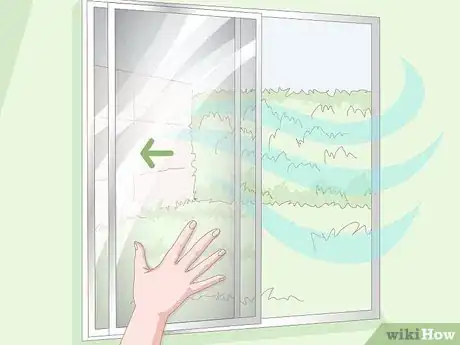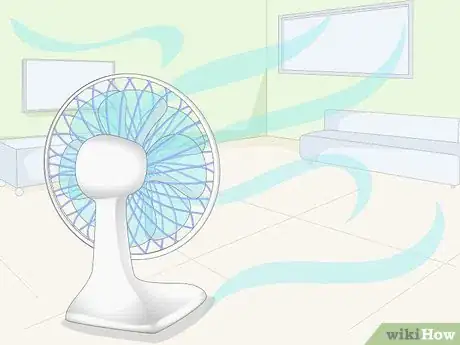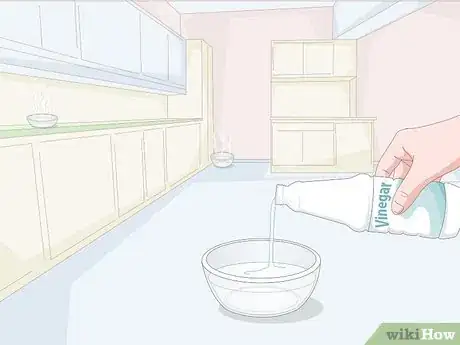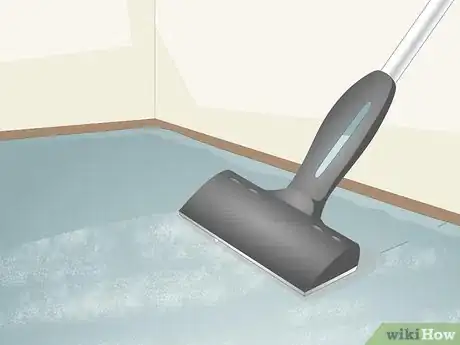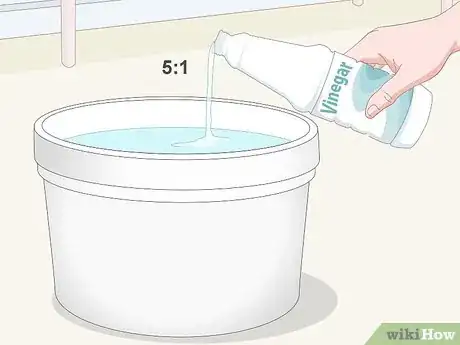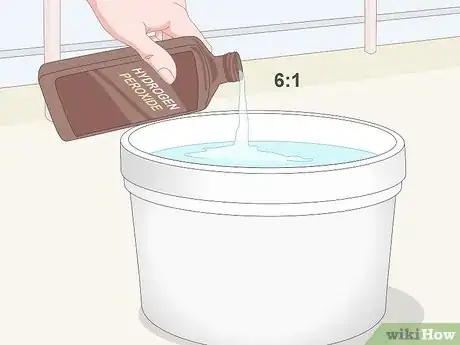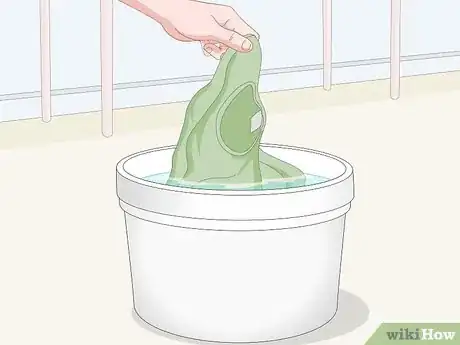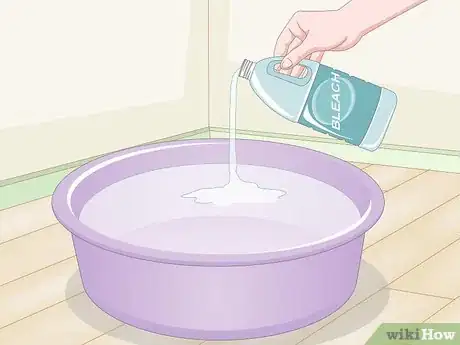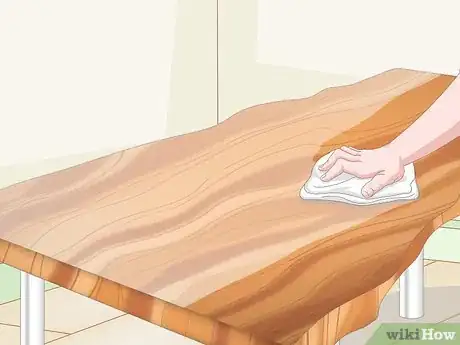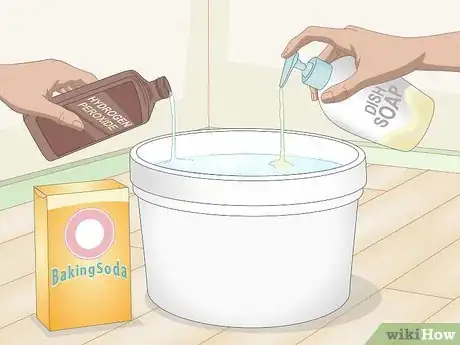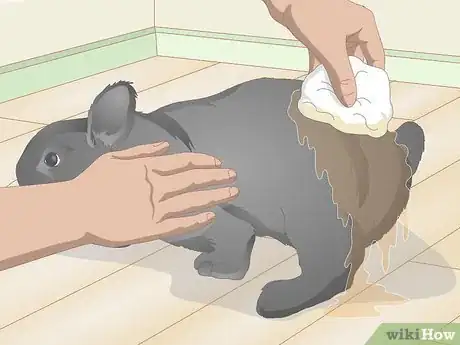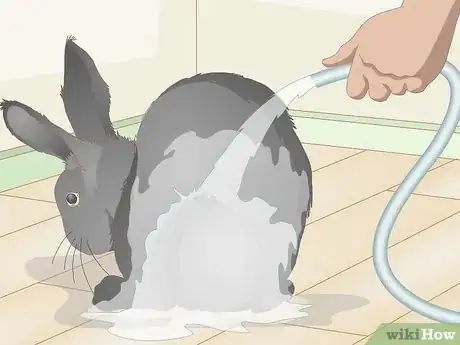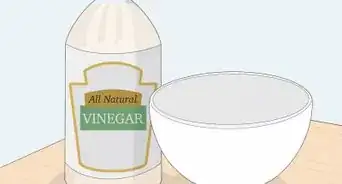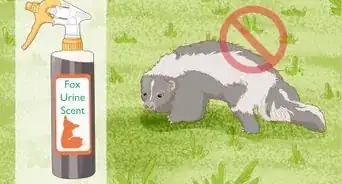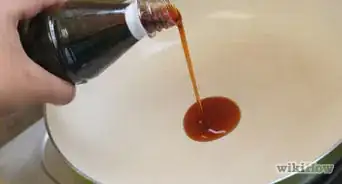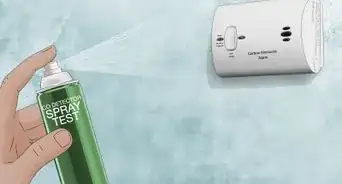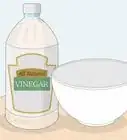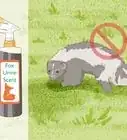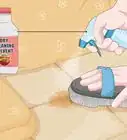This article was co-authored by Eduardo Peralta. Eduardo Peralta is a House Cleaning Specialist and the Manager of Best Maid House Cleaning based in San Jose, California. With over five years of experience, Eduardo and the Best Maid House Cleaning team specialize in home deep-cleaning, post-construction cleaning, and green and eco-friendly cleaning services. Best Maid House Cleaning is fully licensed and insured.
There are 10 references cited in this article, which can be found at the bottom of the page.
This article has been viewed 1,650,805 times.
Skunk smell can get into your house by a variety of sources. For instance, you or your pet might be sprayed, or a skunk could spray something else directly outside of your house. Mild skunk smells can usually be removed by simply airing out your home, but stronger skunk smells that have worked their way into fur, clothes, furniture, or carpeting can linger for several months to several years if immediate action is not taken. If you need to get skunk smell out of your house, start with simple solutions and then work through the different methods until you eliminate it.
Steps
Freshening the Air in Your Home
-
1Open the windows in your home to ventilate it. Let natural sunlight and fresh air into your home to help neutralize the skunk odor. Closing your house up will only keep the stench inside. By opening your windows, you let out some of the smell and allow fresh air into your home to help replace some of the contaminated air.[1]
- However, if a skunk has sprayed right outside your home, don't open windows near the spray until the smell out there has dissipated.
- Sunlight also has a positive effect on smells on fabric. The ultraviolet rays can help neutralize the odor and lift it out of your fabrics.
Tip: If you need to get skunk smell out of clothes, towels, blankets, or other removable fabrics, wash the fabric and hang it to dry outdoors. The direct exposure to sunlight and fresh air will work better at ridding the fabric of the skunk smell than a dryer would.
-
2Run fans to get air moving. Turn on electric ceiling fans, floor fans, and desk fans to keep the air circulating in your home. You can also turn on the fan function of your heating and cooling system, if your system has this function. If you allow the air to remain still and stagnant, the skunk smell will only sink deeper into your fabrics.[2]
- Turning on all the fans in your home as soon as possible helps to keep the air in your house moving, thereby preventing the odor from settling into anything too deeply.
- This works especially well when used in conjunction with opened windows.
Advertisement -
3Change out your furnace filters. Change out your air conditioner and heater filters before and after you treat the rest of your home for skunk odor. The skunk smell can cling to these filters, and as a result, you may end up smelling skunk through your air vents for months. The only way to remedy this is by changing out your air filters.[3]
- Changing the air filters before treating the rest of your home minimizes the amount of stink coming through your vents and re-contaminating the rest of your home.
- Do a sniff test after you clean the rest of your home. Smell the air filters. If they do not smell like skunk, you may not need to change them again. If they do smell like skunk, however, you should replace them once more to prevent the filters from re-contaminating the rest of your home with smelly air.
-
4Spray air deodorizers. Deodorizing air fresheners can mask and remove part of the skunk smell. Look for a spray that specifically indicates its ability to deodorize. Most air fresheners only emit a strong perfume that covers other odors in the home. This will not be enough to deal with skunk smell, however. Only a deodorizing freshener can neutralize and eliminate some of the smell.[4]
- There are also special "de-skunking" sprays that are formulated specifically with the purpose of removing skunk odor. People who use these sprays tend to report mixed results, but you can read reviews about various types online and determine which may be the most effective for your needs.
- You might also have luck with a urine odor spray.[5]
-
5Place bowls of vinegar around the house. If you cannot pinpoint the exact source of the smell, fill small bowls with 1 cup (240 mL) of white vinegar each and place them around the house. Focus on the worst smelling rooms of your home since the source of the stench most likely originates there.[6]
- If you have pets or small children, you may want to consider putting the vinegar high up on shelves to prevent them from spilling or ingesting it.
- The vinegar should absorb much of the smell within 24 hours and the smell of vinegar should not be too overpowering.
Getting Skunk Smell out of Your Carpets
-
1Spread a thin layer of a vacuum-safe odor remover on your carpet. These products typically come in a powder or pellet form that is applied directly to the carpet. Let the cleaner stay on the carpet for at least a half hour, but several hours will work better. This will help remove the smell because the product will absorb it.[7]
- There products are available at most big box, grocery, and home improvement stores.
- Sprinkle the product thinly across the whole surface of the carpet. You don't need a ton to absorb the smell.
Tip: Some people sprinkle baking soda on their carpets to remove smells. However, the particles of baking soda are so small that when you vacuum it up, it can clog your vacuum filter.
-
2Vacuum the carpet to remove the cleaner. Once the cleaner has been on the carpet for at least a half hour, you can simply vacuum it up with your normal vacuum cleaner. Vacuum the surface several times to ensure the you remove all of the odor remover.
- Once you have vacuumed up the odor remover, clean out your vacuum filter and bag or container.
-
3Shampoo your carpets with a steam cleaner if the smell remains. Carpets and other hard-to-wash fabrics, like cloth furniture and curtains, should be washed using a wet vacuum. Steam cleaners work better than ordinary wet vacuums because the heat helps to open and expand the stitching of the fabric. This allows the detergent to sink in further and eliminate more of the skunk smell. An ordinary wet vacuum is still better than nothing, however.
Washing Fabrics
-
1Create a vinegar solution to wash fabrics in. Mix 1 part vinegar with 5 parts warm water in a large bucket. The precise amounts you need will largely depend on how much you need to clean. This solution is meant for clothes, blankets, towels, and other removable fabrics that can be washed in a washing machine.[10]
- Note that some synthetic fabrics and delicate fabrics may not hold up well when exposed to acidic vinegar.
-
2Make a weak solution of hydrogen peroxide as an alternative. Combine 1 part hydrogen peroxide with 6 parts warm water. This solution is safe to use on clothing and other fabrics. The amount you make will depend on how much you need to deodorize.
- As far as fabrics are concerned, this solution is recommended over the stronger hydrogen peroxide solution used to clean pets and people. Strong concentrations of hydrogen peroxide can damage clothes, but when diluted with water, it should be safe to use on normal fabrics.
- Avoid using this solution on delicate fabrics or "dry clean only" clothes.
-
3Soak contaminated fabrics in the solution. Dip your contaminated clothes and other fabrics into the diluted vinegar or hydrogen peroxide. Let them soak for 2 to 3 hours. For best results, use your hands to gently scrub the fabric for several minutes after dipping it into the solution. Doing so works the liquid in between the fibers of the fabric, allowing it to penetrate further and deodorize more of the smell.[11]
- Items you might want to soak include pillow covers, slipcovers, curtains, and blankets, as well as any other fabrics that have the skunk smell on them.
Tip: This treatment is most effective when performed within 1 to 2 hours of contamination.
-
4Wash the fabrics in a washing machine after they have soaked. After removing your fabrics from the cleaning solution, wash them in a standard warm wash cycle. For extra deodorizing power, add 1/2 cup (90 grams) of baking soda to the washing machine at the beginning of the wash cycle.[12]
- If possible, air dry the fabrics in the sun. The fresh air is better at getting rid of the smell than drying in the dryer.
Cleaning Hard Surfaces with a Bleach Solution
-
1Dilute bleach with water. Combine 1 cup (250 ml) of bleach with 1 gallon (4 liters) of warm water. Put it in an open container, such as a utility bucket.[13]
- When working with bleach, it is best to avoid using other chemicals or cleaners, since many will have a chemical reaction with the bleach that may produce a toxic gas.
- It is also wise to keep the room well-ventilated by opening windows and doors. Do not work with bleach in a closed room.
-
2Scrub hard surfaces with this solution. Dip a scrubbing brush into the bleach and use it to wash kitchen floors, counters, car tires, decks, or other contaminated hard surfaces. However, do not use this solution on carpets, upholstery, or other fabrics since bleach is likely to discolor fabrics.
- Avoid using this solution on clothes. You can add bleach to whites, according to label directions, but darker colors should not be bleached.[14]
- To protect your hands, you may want to wear rubber cleaning gloves as you work with the bleach solution.
Tip: If you do not have a scrubbing brush, you could also use a clean rag or abrasive sponge.
-
3Rinse and repeat as needed. Wash off the bleach with a clean rag soaked in warm water. Repeat the process as necessary in order to remove the smell from your surfaces.
- Dry the surfaces with a clean, dry cloth after finishing.
Removing the Smell from People and Pets
-
1Make a mixture of hydrogen peroxide, baking soda, and soap. Mix together 1 quart (1 liter) hydrogen peroxide, 1/4 cup (45 grams) of baking soda, and 1 tsp (5 ml) liquid laundry detergent or dish detergent. Combine the ingredients in an open container, such as a bucket.[15]
- Use 3 percent hydrogen peroxide, if possible.
- Do not close the container after mixing the ingredients together. The gas that will be produced could build up and create enough pressure to pop off a lid.
- Note that you may need to make more of the solution for a bigger dog or adult human.
- Do not store this mixture. Use it as soon as you mix it together.
Tip: For more stubborn skunk odors, you may need to up the amount of baking soda to 1/2 cup (90 grams) and the amount of soap to 1 Tbsp (15 ml).
-
2Saturate the skunked area. Dip a clean washcloth in the solution that you made. Use the washcloth to cover all of the contaminated fur and skin with the solution until it is dripping wet.
- This solution is safe for both pets and humans, but you should avoid getting it into eyes, ears, or mouths. While it is safe for skin, it can sting and damage eyes or other sensitive areas.
-
3Scrub the area with the solution. Use the washcloth to scrub the skunked pet or human with this solution. Make sure you get down to the skin on your pets, even if they have thick fur. Let it sit for 5 minutes to really eliminate the smell.[16]
- This works best if done within an hour or 2 after contamination.
-
4Rinse the area with clean water. After you have thoroughly cleaned the area, use fresh water to remove the solution from the skin or fur. Rinse the area several times to ensure that all of the solution is gone.[17]
- Repeat the soaking, scrubbing, and rinsing as necessary until you can no longer smell the skunk.
Expert Q&A
-
QuestionWhat neutralizes skunk smell?
 Eduardo PeraltaEduardo Peralta is a House Cleaning Specialist and the Manager of Best Maid House Cleaning based in San Jose, California. With over five years of experience, Eduardo and the Best Maid House Cleaning team specialize in home deep-cleaning, post-construction cleaning, and green and eco-friendly cleaning services. Best Maid House Cleaning is fully licensed and insured.
Eduardo PeraltaEduardo Peralta is a House Cleaning Specialist and the Manager of Best Maid House Cleaning based in San Jose, California. With over five years of experience, Eduardo and the Best Maid House Cleaning team specialize in home deep-cleaning, post-construction cleaning, and green and eco-friendly cleaning services. Best Maid House Cleaning is fully licensed and insured.
House Cleaning Specialist Try using an enzymatic cleaner, but know that a professional cleaning might be necessary. Either way, make sure you treat it as soon as possible to keep the stench from fixating.
Try using an enzymatic cleaner, but know that a professional cleaning might be necessary. Either way, make sure you treat it as soon as possible to keep the stench from fixating.
Things You'll Need
Freshening the Air in Your House
- Electric fans
- Air filters
- Air deodorizers
Getting Skunk Smell Out of Your Carpets
- Carpet odor remover
- Carpet shampoo
- Wet-vacuum or steam cleaner
Washing Fabrics
- White vinegar or 3 percent hydrogen peroxide
- Baking soda
- Water
- Scrubbing brush or sponge
- Large bucket or container
- Washing machine
Cleaning Hard Surfaces with a Bleach Solution
- Bleach
- Scrubbing brush or sponge
- Water
- Large bucket or container
- Washing machine
- Rubber gloves
Removing the Smell from People and Pets
- 3 percent hydrogen peroxide
- Baking soda
- Wash cloth
- Water
- Large bucket or container
References
- ↑ Victor Belavus. Air Conditioning Specialist. Expert Interview. 6 May 2020.
- ↑ Victor Belavus. Air Conditioning Specialist. Expert Interview. 6 May 2020.
- ↑ Victor Belavus. Air Conditioning Specialist. Expert Interview. 6 May 2020.
- ↑ https://www.goodhousekeeping.com/home/cleaning/tips/a20882/neutralize-skunk-odor-mar02/
- ↑ Eduardo Peralta. House Cleaning Specialist. Expert Interview. 29 October 2021.
- ↑ https://www.familyhandyman.com/cleaning/how-to-get-rid-of-skunk-smell/
- ↑ https://www.thriftyfun.com/Removing-Skunk-Smell-from-House-1.html
- ↑ Eduardo Peralta. House Cleaning Specialist. Expert Interview. 29 October 2021.
- ↑ Eduardo Peralta. House Cleaning Specialist. Expert Interview. 29 October 2021.
- ↑ https://www.goodhousekeeping.com/home/cleaning/tips/g1889/household-cleaning-remedies/?slide=2
- ↑ https://www.familyhandyman.com/cleaning/how-to-get-rid-of-skunk-smell/
- ↑ https://www.familyhandyman.com/cleaning/how-to-get-rid-of-skunk-smell/
- ↑ http://www.mvmagazine.com/article.php?24895
- ↑ https://getridofthings.com/get-rid-of-skunk-smell/
- ↑ http://www.lynnskitchenadventures.com/2009/03/getting-rid-of-skunk-smell.html
- ↑ https://www.goodhousekeeping.com/home/cleaning/tips/a20882/neutralize-skunk-odor-mar02/
- ↑ https://www.goodhousekeeping.com/home/cleaning/tips/a20882/neutralize-skunk-odor-mar02/
- ↑ https://www.angieslist.com/articles/how-get-rid-skunk-smell-your-home.htm
- ↑ https://www.goodhousekeeping.com/home/cleaning/tips/g1889/household-cleaning-remedies/?slide=2
About This Article
To get skunk smell out of your house, start by opening up all of the windows to ventilate your space. Next, turn on your ceiling fans or place box fans in each room to get the air circulating. You can also try placing bowls of white vinegar in each room, which will absorb the smell over a 24-hour period. Machine wash any clothes and fabrics that smell and clean carpets and furniture with a wet vacuum or steam cleaner. Be sure to wipe down all of the hard surfaces in your house with diluted bleach to eliminate any traces of the scent. Finally, change out your air conditioner and heater filters, since the skunk smell will cling to the old ones. For more tips on treating stinky carpets and rugs, scroll down!
